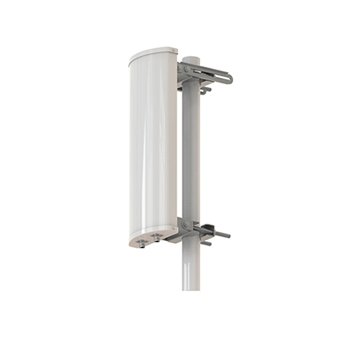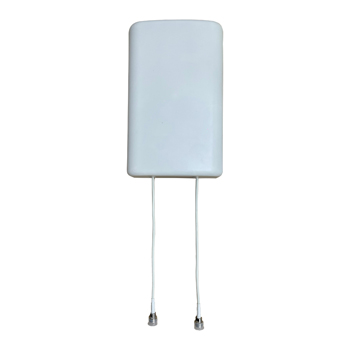
Antennas are devices that are used to handle wireless communication by converting the required information signal into electromagnetic waves. Antennas can be either transmitting antennas or receiving antennas, they can be classified into different types based on their physical structure, operating frequency ranges, or modes of application.
Omnidirectional antennas are one of the popular types of antennas which can receive and broadcast signals equally in all directions making them ideal for many applications such as FM radios, Wi-Fi routers, cell phones, etc.
This article provides a comprehensive overview of what an omnidirectional antenna is, how it operates, its applications, advantages and disadvantages, how to select an antenna, etc.
Table of Contents
ToggleWhat is an omnidirectional antenna?
Omnidirectional antennas are one of the most important types of antennas in wireless communication. Unlike directional antenna that focus energy on one direction, omni antenna have a 360-degree reception pattern and can radiate or intercept radio frequency electromagnetic fields equally in all horizontal directions. They have a balanced gain across all frequencies and can provide a consistent coverage over a broad area making them ideal for applications where the signal direction is varying or cannot be predetermined.
Omnidirectional and directional antennas differ based on the direction of radiation. A directional antenna cannot receive and broadcast signals equally in all directions like an omnidirectional antenna. It has a radiation pattern limited to around 45 to 90 degrees radius. A directional antenna is focused on a certain direction and has limited connectivity area but has better interference tolerance from other directions and thus can produce a higher throughput for the selected direction. Omnidirectional antennas, despite having a 360-degree connectivity area, tend to have a lower gain and require more power to transmit signals over a longer distance.
How do omnidirectional antennas work?
Omnidirectional antennas have a doughnut-shaped radiation pattern when viewed from the top with the antenna at the center. They radiate equal power in all directions perpendicular to the axis with the power varying with the axis angle declining to zero on the axis. The range of omnidirectional can extend up to a few hundred meters but it varies depending on several factors such as the frequency used, the power output of the transmitter, the height and placement of the antenna, and the surrounding environment.
Types of omnidirectional antennas
There are different types of omnidirectional antennas.
- Dipole Antenna: A dipole antenna has two conductive elements like metal wires or rods oriented in a straight line and in the center of the dipole antenna, the conductive materials are separated using an insulator. The RF voltage source is provided in the center of the antenna. Then the voltage and current passing through these 2 conductive elements produce electromagnetic or radio signals which are radiated in all directions out of the antenna.
- Monopole Antenna: A monopole antenna is a straight rod-shaped conductor that is perpendicularly mounted above a ground plan. It is half of a dipole antenna. The conducting rod works like a resonator and radiates incoming signals in all directions vertical to the antenna’s length above the ground plane.
- Collinear Antenna: A collinear antenna is a type of a half-wave dipole antenna and has multiple dipoles stacked vertically on top of each other increasing the gain of the antenna in the vertical direction.
- Whip Antenna: A whip antenna is a metal wire or rod that is flexible. They are mostly used in portable radios, walkie-talkies, car antennas, etc.
- Ground Plane Antenna: Ground plane antennas use a conductive ground plane mounted above the ground to improve the antenna’s performance.
Applications of omnidirectional antennas
Omnidirectional antennas are commonly used in applications where the signal directions are not predetermined or need to be accessible from a wider area without the need for antenna adjustment.
- Cellular Networks: Omnidirectional antennas are used in cellular networks enabling coverage in all directions allowing users from a larger area to connect to the cellular network.
- Wi-Fi Routers: Wi-Fi routers and access points also use omnidirectional antennas. This enables multiple users and devices to get consistent signal coverage throughout the designated area.
- Broadcasting: Omnidirectional antennas play a major role in radio and television broadcasting by transmitting signals in all directions so that anyone within the broadcast range can receive the signal with a regular antenna.
- Maritime and Aviation: Maritime and aviation industries make use of omnidirectional antennas in their communication systems to provide coverage in all directions allowing vessels and aircraft to communicate with signal towers as well as other vessels or aircraft in the region regardless of their orientation.
Besides these applications, omnidirectional antennas are used in various other industries and communication systems.
Advantages and Disadvantages of Omnidirectional Antennas
There are many advantages to using omnidirectional antennas.
- Wide area coverage: One of the key benefits is the 360-degree coverage. The ability to receive and transmit signals in all directions equally provides a wide coverage area enabling communication with multiple devices in all directions without the need for reorientation.
- Simple design and ease of installation: Omnidirectional antennas have a simple design structure and are also easier to install. They can work efficiently without needing precise alignment or adjustment.
- Cost-effective: Omnidirectional antennas are also cost-effective when compared to directional antennas.
- Easy to install: Omni-directional antennas can transmit and receive signals in all directions, so they do not need to be aimed at a target during installation.
Omnidirectional antennas have a slight disadvantage over directional antennas in terms of antenna gain. In directional antennas, since the signal is focused and concentrated in a specific direction, they tend to have a higher gain and can transmit to a longer distance than omnidirectional antennas. Omnidirectional antennas are prone to a higher amount of signal interference as they are subject to interferences in all directions.
Choosing an omnidirectional antenna
Several factors need to be considered when selecting an omnidirectional antenna such as the specific application requirements, operating frequency range, electrical characteristics such as the gain, peak voltage, and level of interference, and environmental specifications such as the wind strength, temperature and lightning protection, and the operating bandwidth.
To set up an omnidirectional antenna a central location that has minimum obstructions needs to be selected. To optimize the performance of the omnidirectional antenna, place it at a higher location and adjust the angle and direction of it to fine-tune the signal strength and maximize the range.
Millimeter Wave Product, Inc. based in USA, Tesswave in China, Synergy Telecom Pvt. Ltd. based in India, and Hefei Maniron Electronic and Technology Co., Ltd. based in China are among the top three manufacturers of omnidirectional antennas. Among the different types of omnidirectional antennas, dipole antennas are the most common and widely used in applications.
Conclusion
In summary, omnidirectional antennas are antennas that can transmit and receive signals in all directions evenly making them an important part of modern communication systems. They are widely used in mobile networks, Wi-Fi routers, and radio and television broadcasting. Various types of omnidirectional antennas are available and selecting the correct antenna for an application is crucial.
There is huge potential in omnidirectional antennas in the future with the technological advancement in areas such as 5G and IoT. Opportunities in the omnidirectional antenna market are also driven by the increase in the number of connected devices, the increase in demand for reliable and consistent data transmission, and concepts such as smart cities.








